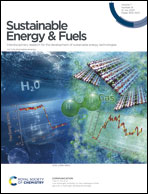Electro- and photochemical H2 generation by Co(ii) polypyridyl-based catalysts bearing ortho-substituted pyridines†
Abstract
Cobalt(II) complexes featuring hexadentate amino-pyridyl ligands have been recently discovered as highly active catalysts for the Hydrogen Evolution Reaction (HER), whose high performance arises from the possibility of assisting proton transfer processes via intramolecular routes involving detached pyridine units. With the aim of gaining insights into such catalytic routes, three new proton reduction catalysts based on amino-polypyridyl ligands are reported, focusing on substitution of the pyridine ortho-position. Specifically, a carboxylate (C2) and two hydroxyl substituted pyridyl moieties (C3, C4) are introduced with the aim of promoting intramolecular proton transfer which possibly enhances the efficiency of the catalysts. Foot-of-the-wave and catalytic Tafel plot analyses have been utilized to benchmark the catalytic performances under electrochemical conditions in acetonitrile using trifluoroacetic acid as the proton source. In this respect, the cobalt complex C3 turns out to be the fastest catalyst in the series, with a maximum turnover frequency (TOF) of 1.6 (±0.5) × 105 s−1, but at the expense of large overpotentials. Mechanistic investigations by means of Density Functional Theory (DFT) suggest a typical ECEC mechanism (i.e. a sequence of reduction – E – and protonation – C – events) for all the catalysts, as previously envisioned for the parent unsubstituted complex C1. Interestingly, in the case of complex C2, the catalytic route is triggered by initial protonation of the carboxylate group resulting in a less common (C)ECEC mechanism. The pivotal role of the hexadentate chelating ligand in providing internal proton relays to assist hydrogen elimination is further confirmed within this novel class of molecular catalysts, thus highlighting the relevance of a flexible polypyridine ligand in the design of efficient cobalt complexes for the HER. Photochemical studies in aqueous solution using [Ru(bpy)3]2+ (where bpy = 2,2′-bipyridine) as the sensitizer and ascorbate as the sacrificial electron donor support the superior performance of C3.

- This article is part of the themed collection: Recent Open Access Articles


 Please wait while we load your content...
Please wait while we load your content...